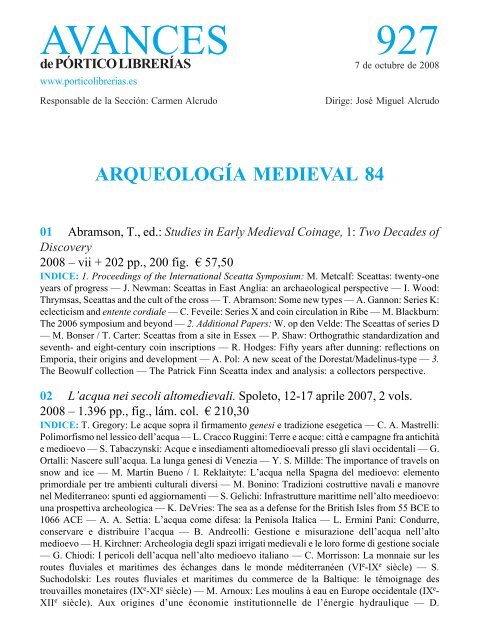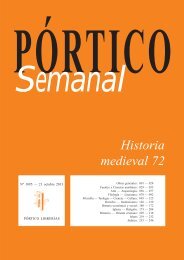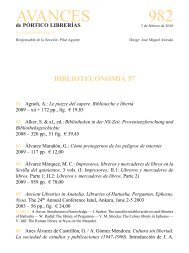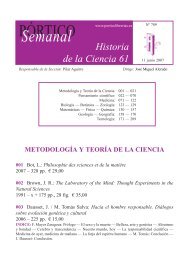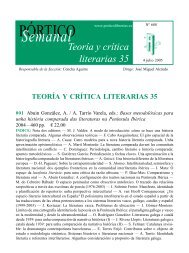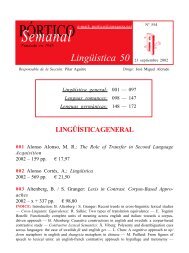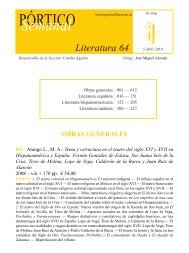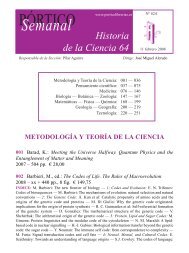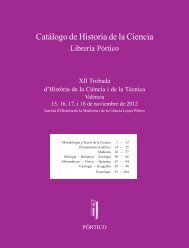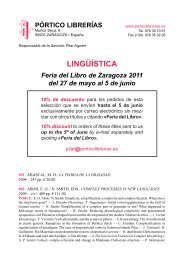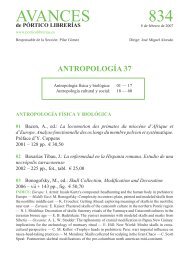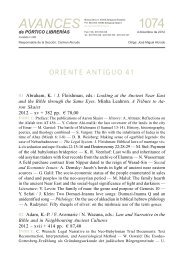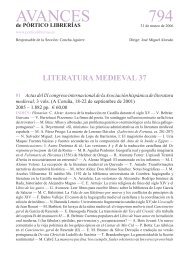Arqueología medieval 84 - Pórtico librerías
Arqueología medieval 84 - Pórtico librerías
Arqueología medieval 84 - Pórtico librerías
Create successful ePaper yourself
Turn your PDF publications into a flip-book with our unique Google optimized e-Paper software.
AVANCES<br />
927<br />
de PÓRTICO LIBRERÍAS 7 de octubre de 2008<br />
www.porticolibrerias.es<br />
Responsable de la Sección: Carmen Alcrudo<br />
Dirige: José Miguel Alcrudo<br />
ARQUEOLOGÍA MEDIEVAL <strong>84</strong><br />
01 Abramson, T., ed.: Studies in Early Medieval Coinage, 1: Two Decades of<br />
Discovery<br />
2008 – vii + 202 pp., 200 fig. € 57,50<br />
INDICE: 1. Proceedings of the International Sceatta Symposium: M. Metcalf: Sceattas: twenty-one<br />
years of progress — J. Newman: Sceattas in East Anglia: an archaeological perspective — I. Wood:<br />
Thrymsas, Sceattas and the cult of the cross — T. Abramson: Some new types — A. Gannon: Series K:<br />
eclecticism and entente cordiale — C. Feveile: Series X and coin circulation in Ribe — M. Blackburn:<br />
The 2006 symposium and beyond — 2. Additional Papers: W. op den Velde: The Sceattas of series D<br />
— M. Bonser / T. Carter: Sceattas from a site in Essex — P. Shaw: Orthograthic standardization and<br />
seventh- and eight-century coin inscriptions — R. Hodges: Fifty years after dunning: reflections on<br />
Emporia, their origins and development — A. Pol: A new sceat of the Dorestat/Madelinus-type — 3.<br />
The Beowulf collection — The Patrick Finn Sceatta index and analysis: a collectors perspective.<br />
02 L’acqua nei secoli alto<strong>medieval</strong>i. Spoleto, 12-17 aprile 2007, 2 vols.<br />
2008 – 1.396 pp., fig., lám. col. € 210,30<br />
INDICE: T. Gregory: Le acque sopra il firmamento genesi e tradizione esegetica — C. A. Mastrelli:<br />
Polimorfismo nel lessico dell’acqua — L. Cracco Ruggini: Terre e acque: città e campagne fra antichità<br />
e medioevo — S. Tabaczynski: Acque e insediamenti altomedioevali presso gli slavi occidentali — G.<br />
Ortalli: Nascere sull’acqua. La lunga genesi di Venezia — Y. S. Millde: The importance of travels on<br />
snow and ice — M. Martín Bueno / I. Reklaityte: L’acqua nella Spagna del medioevo: elemento<br />
primordiale per tre ambienti culturali diversi — M. Bonino: Tradizioni costruttive navali e manovre<br />
nel Mediterraneo: spunti ed aggiornamenti — S. Gelichi: Infrastrutture marittime nell’alto meedioevo:<br />
una prospettiva archeologica — K. DeVries: The sea as a defense for the British Isles from 55 BCE to<br />
1066 ACE — A. A. Settia: L’acqua come difesa: la Penisola Italica — L. Ermini Pani: Condurre,<br />
conservare e distribuire l’acqua — B. Andreolli: Gestione e misurazione dell’acqua nell’alto<br />
medioevo — H. Kirchner: Archeologia degli spazi irrigati <strong>medieval</strong>i e le loro forme di gestione sociale<br />
— G. Chiodi: I pericoli dell’acqua nell’alto medioevo italiano — C. Morrisson: La monnaie sur les<br />
routes fluviales et maritimes des échanges dans le monde méditerranéen (VI e -IX e siècle) — S.<br />
Suchodolski: Les routes fluviales et maritimes du commerce de la Baltique: le témoignage des<br />
trouvailles monetaires (IX e -XI e siècle) — M. Arnoux: Les moulins à eau en Europe occidentale (IX e -<br />
XII e siècle). Aux origines d’une économie institutionnelle de l’énergie hydraulique — D.
PÓRTICO LIBRERÍAS AVANCES 927 — <strong>Arqueología</strong> <strong>medieval</strong> <strong>84</strong> 2<br />
Makowiecki: Exploitation of early <strong>medieval</strong> aquatic environments in Poland and other Baltic sea<br />
countries: an arcaheozoological consideration — M. Montanari: Il sapore dell’acqua — C. Cattaneo:<br />
Modificazioni dello stato di salute indotte dalla vicinanza a corsi d’acqua: studio su popolazioni<br />
<strong>medieval</strong>i — L. R. Angeletti: Usi terapeutici delle acque nella trattatistica medica della tarda antichità<br />
(secoli IV-VII d.C.) — F. R. Stasolla: Tra igiene e piacere: thermae e balnea nell’alto medioevo — S.<br />
Casartelli Novelli: Il simbolo dell’acqua di vita — A. Iacobini: «Hoc elementum ceteris omnibus<br />
imperat». L’acqua nell’universo visuale dell’alto medioevo — P. G. Spanu: Fons vivus. Culti delle<br />
acque e santuari cristiani tra tarda antichità e alto medioevo — R. Budriesi: I santuari del mare. Una<br />
frontiera del sacro per reliquie e uomini sull’acqua — G. Cremascoli: Simbologia e teologia battesimali<br />
— M. Falla Castelfranchi: L’edificio battesimale: architettura, ritualità, sistemi idraulici — T. Pàroli:<br />
L’acqua come elemento tra vita e morte nella cultura germanica <strong>medieval</strong>e — A. M. Orselli: I monaci<br />
tardoantichi in dialogo con l’acqua.<br />
03 Almagro Vidal, A.: El concepto de espacio en la arquitectura palatina<br />
andalusí. Un análisis perceptivo a través de la infografía<br />
2008 – 372 pp., lám. col., fig. € 45,00<br />
INDICE: Hacia un nuevo concepto de documentación en el campo del conocimiento y la valorización<br />
del patrimonio arquitectónico — La evolución del lenguaje gráfico: contextos virtuales aplicados al<br />
conocimiento del patrimonio y su conservación — Metodología para la generación del modelo: el caso<br />
de la Aljafería de Zaragoza — Situación actual de la documentación de la arquitectura palatina andalusí<br />
— Análisis perceptivo de la evolución del espacio en la arquitectura palatina andalusí —<br />
Conclusiones.<br />
04 Arnold, F.: Der islamische Palast auf der Alcazaba von Almería<br />
2008 – 348 pp., 139 fig., despl. € 119,60<br />
INDICE: L. Cara Barrionuevo: La alcazaba de Almería como monumento: investigación, patrimonio<br />
y restauración — F. Arnold: Die Architektur — L. Cora Barrionuevo: Alcazaba de Almería en la época<br />
cristiana — P. Cressier: Chapiteaux, bases et tailloirs des monuments islamiques d’Almería — N.<br />
Kubisch: Las yeserías islámicas.<br />
05 Arnon, y. D.: Caesarea Maritima, the Late Periods (700-1291 CE)<br />
2008 – iv + 434 pp., fig., lám. € 98,00<br />
06 <strong>Arqueología</strong> y territorio <strong>medieval</strong>, 11.2. Monográfico: Las murallas de Jaén<br />
2004 – 197 pp., lám., fig., plan. € 30,00<br />
INDICE: J. L. Serrano Peña: Las fortificaciones de Orongis/Aurgi — J. L. Castillo Armenteros / J. Cano<br />
Carrillo: La muralla norte — V. Salvatierra Cuenca: Las murallas urbanas — V. Barba Colmenero & al.:<br />
Nuevos datos para el estudio del sistema de fortificación <strong>medieval</strong> de la ciudad de Jaén. Intervención<br />
arqueológica en la Puerta de Martos — M. C. Pérez Martinez / A. Lopez Marcos / M. A. de Dios Pérez:<br />
La puerta del Aceituno — F. Arias de Haro & al.: El Doso defensivo del sistema de fortificación de la<br />
ciudad <strong>medieval</strong> del Jaén. Excavación arqueológica en el solar de la calle Millán de Priego nº 59 — M.<br />
Navarro Pérez & al.: Intervencion arqueológica en la Puerta de Baeza. Nuevas aportaciones al sistema<br />
fortificado de la ciudad <strong>medieval</strong> de Jaén — F. Martín / B. Martín: Caracterización de materiales e
PÓRTICO LIBRERÍAS AVANCES 927 — <strong>Arqueología</strong> <strong>medieval</strong> <strong>84</strong> 3<br />
intervención sobre un tramo de la muralla sur de Jaén — J. C. Castillo Armenteros / M. B. Luna<br />
Collantes: La muralla sureste de Jaén.<br />
07 Belaubre, J.: Dictionnaire de numismatique médiévale occidentale<br />
1996 – 151 pp., fig. € 33,00<br />
08 Berti, G. / G. Bianchi, eds.: Piombino. La chiesa di Sant’Antimo sopra i<br />
Canali. Ceramiche e architetture per la lettura archeologica di un abitato<br />
<strong>medieval</strong>e e del suo porto<br />
2007 – 412 pp., fig., lám. col. € 52,00<br />
INDICE: G. Bianchi: L’indagine nel complesso architettonico di Sant’Antimo sopra i Canali. Il<br />
contesto urbano di riferimento e la ricerca archeologica — M. L. Ceccarelli Lemut: L’edificio attraverso<br />
le fonti scritte — G. Fichera: Archeologia dell’architettura del cantiere di costruzione della chiesa —<br />
G. Fichera: Lo scavo del riempimento della volta — S. Liguori: Le ceramiche della volta absidale con<br />
rivestimenti vetrificati — C. Capelli / R. Cabella: Analisi archeometriche in sezione sottile di alcuni<br />
reperti ceramici e di laterizi — F. Grassi: Le ceramiche non rivestite e con rivestimenti vetrosi rinvenute<br />
nella volta absidale — G. Berti: Le ceramiche della torre campanaria — A. Pecci / L. Salvini: Analisi<br />
dei residui organici assorbiti nelle ceramiche non rivestite del riempimento della volta absidale — R.<br />
Belcari: Plastica architettonica e scultura del duecento a Piombino — G. Berti: Le ceramiche di<br />
Sant’Antimo nel quadro delle importazioni e delle produzioni locali di Pisa nel XIII secolo — G.<br />
Bianchi: Dalla progettazione di una chiesa, alla definizione degli assetti abitativi della Val di Cornia<br />
tra XIII e XIV secolo.<br />
09 Bianchi, B.: Arabia e Palaestina dall’impero al Califfato<br />
2007 – 250 pp., 133 fig. € 30,00<br />
10 Boletín de arqueología <strong>medieval</strong>, 13 — 2007: Actas de la reunión de castillos<br />
valencianos (Onda, Castellón)<br />
2007 – 341 pp., fig. € 30,00<br />
INDICE: Actas de la reunión de castillos valencianos: A. Ruibal: Avance del «Inventario de<br />
fortalezas de la Comunidad Valenciana» de la Asociación española de amigos de los castillos — A.<br />
Ruibal: Usos de las fortalezas de las órdenes militares en la corona de Aragón — A. M. Poveda Navarro<br />
/ J. C. Márquez Villora: El castillo de Elda: la investigación arqueológica (1980-2003) — L.<br />
Hernández Alcaraz / C. Navarro Poveda: «Graffiti» del Castillo de la atalaya (Villena, Alicante).<br />
Representaciones navales — A. J. Lorrio / M. D. Sánchez de Prado: El Molón: (Camporrobles,<br />
Valencia). Un asentamiento alto<strong>medieval</strong> en la comarca de Utiel-Requena — M. Gómez Sauquillo: El<br />
castell de Corbera com a reclam turistic d’una comarca — I. Moraño Poblador & al.: El castell d’Artana<br />
(Artana, Castellón): primeras compañas de excavaciones arqueológicas — F. Palomir Granell:<br />
Resultados de campo del trabajo realizado en el castillo de Culla (Alto Maestrazgo, Castellón).<br />
Memoria de las actividades (2003) — A. M. Barrachina Ibáñez / J. M. de Antonio Otal: Últimas<br />
aportaciones al conocimiento de las defensas del castillo de Morella: interpretación de la Torre del<br />
panto y sus espacios adyacentes — J. Alfonso Llorens / V. J. Estall i Poles: La recuperación del castillo
PÓRTICO LIBRERÍAS AVANCES 927 — <strong>Arqueología</strong> <strong>medieval</strong> <strong>84</strong> 4<br />
de Onda (Castellón) — M. Sánchez Martín / A. Barrachina Ibáñez: Reflexiones sobre el recinto<br />
fortificado <strong>medieval</strong> de la ciudad de Segorbe - Alto Palancia (Castellón, España) — J. M. de Antonio<br />
Otal / D. Vizcaíno León: La orden del temple en Chivert (1234-1312) — Artículos: A. Zamora<br />
Canellada: Una nueva patena y un jarro de época visigoda en el museo de Segovia — J. Camino Mayor<br />
& al.: Un sistema de fortificaciones lineales astures en la Cordillera cantábrica a finales del reino<br />
visigodo — J. A. Aparicio Bastardo: Recuperación de un capitel alto<strong>medieval</strong> en Villafrance Montes<br />
de Oca (Burgos) — P. J. Ripoll Vivancos: Ciruela: Hisn al Sujayrola — A. Serra i Clota: La forma<br />
constructiva del manso en la Cataluña del s. XII: un panorama diverso — M. C. Riu de Martín: El<br />
obrador y la vivienda de un ceramista barcelonés de fines del siglo XV y principios del siglo XVI: Joan<br />
Feliu. Estudio comparativo.<br />
11 Bolos, J.: Els orígens <strong>medieval</strong>s del paisatge català. L’arqueologia del<br />
paisatge com a font per a conèixer la historia de Catalunya<br />
2004 – 463 pp., 147 fig. € 29,00<br />
12 Brather, S., ed.: Zwischen Spätantike und Frühmittelalter. Archaeologie des<br />
4. bis 7. Jahrhunderts im Westen<br />
2008 – vii + 480 pp., 111 fig. € 128,00<br />
INDICE: S. Brather: Archäologie des 4. bis 7. Jahrhunderts im Westen. Einführung — 1. Geschichte<br />
und Archäologie: W. Pohl: Spuren, Texte, Identitäten. Methodische Überlegungen zur<br />
interdisziplinären Erforschung frühmimttelalterlicher Identitätsbildung — M. Kulikowski: Wie<br />
Spanien gotisch wurde. Der Historiker und der archäologische Befund — P. von Rummel: Ambrosius,<br />
Julianus Valens und die «gotische Kleidung». Eine Schlüsselstelle historisch-archäologischer<br />
Interpretation — 2. Von der Spätantike zum Frühmittelalter: H. Fehr: Germanische Einwanderung<br />
oder kulturelle Neuorientierung? Zu den Anfängen des Reihengräberhorizontes — G. Halsall:<br />
Gräberfelduntersuchungen und das Ende des römischen Reichs — B. Effros: Auf der Suche nach<br />
Frankreichs ersten Christen. Camille de la Croix und die Schwierigkeiten eines Klerikers als<br />
Archäologe im späten 19. Jahrhundert — 3. Archäologie der gentes: M. Kazanski / A. Mastykova / P.<br />
Périn: Westgoten in Nordgallien aus Sicht der Archäologie. Zum Stand der Forschung — A. Jepure:<br />
Interpretationsprobleme der Westgotenarchäologie. Zurück zu den Altgrabungen anhand bisher<br />
unausgewerteter Dokumentationen — C. Theune: Methodik der ethnischen Deutung. Überlegungen<br />
zur Interpretation der Grabfunde aus dem thüringischen Siedlungsgebiet — 4. Bestattung und<br />
Identität: S. Brather: Kleidung, Bestattung, Ritual. Die Präsentation sozialer Rollen im frühen<br />
Mittelalter — E. Stauch: Alter ist Silber, Jugend ist Gold! Zur altersdifferenzierten Analyse<br />
frühgeschichtlicher Bestattungen — K. H. Nielsen: Still II als Spiegel einer Elitenidentität? Der<br />
Tierstil von der Herkunftsmythologie bis zur Königssymbolik und Kirchenkunst im<br />
angelsächsischen Britannien — L. Blackmore: Schätze eines angelsächsischen Königs von Essex. Die<br />
Funde aus einem Prunkgrab von Prittlewell und ihr Kontext — 5. Handwerk und Austausch: H.-U.<br />
Voss: Fremd - nützlich - machbar. Römische Einflüsse im germanischen Feinschmiedehandwerk — J.<br />
Drauschke: Zur Herkunft und Vermittlung «byzantinischer Importe» der Merowingerzeit in<br />
Nortdwesteuropa — S. Brather: Zwischen Spätantike und Frühmittelalter. Zusammenfassung.<br />
13 Burnouf, J.: Archéologie médiévale en France. Le second moyen âge (XII e -
PÓRTICO LIBRERÍAS AVANCES 927 — <strong>Arqueología</strong> <strong>medieval</strong> <strong>84</strong> 5<br />
XVI e siècle)<br />
2008 – 180 pp., lám. col. € 22,00<br />
14 Carmona Berenguer, S.: Mundo funerario rural en la Andalucía tardoantigua<br />
y de época visigoda. La necrópolis de El Ruedo (Almedinilla, Córdoba)<br />
1998 – 390 pp., fig., fot. € 12,02<br />
15 Carta, R., ed.: Arqueometría y arqueología <strong>medieval</strong><br />
2006 – 217 pp., fig., tabl. € 21,00<br />
INDICE: R. Carta: Introdución — T. Mannoni: <strong>Arqueología</strong>, arqueometría e historia de la cultura<br />
material — J. Capel Martínez: Ciencias de la Tierra y arqueología — C. Capelli / R. Cabella: La<br />
contribución del análisis minero-petrográfico en el estudio de las cerámicas <strong>medieval</strong>es mediterráneas<br />
— E. Fernández Navarro: Aplicación del microscopio electrónico de barrido al estudio de la<br />
tecnología de la cerámica de cocina de época almohade-nazari — C. Capelli & al.: Análisis<br />
arqueométrico y arqueológico integrado sobre azulejos vidriados hallados en contextos de los siglos<br />
XIV al XVI en Liguria (Italia): las producciones de Málaga y Savona — J. F. Rodríguez Gordillo:<br />
Morteros como elementos de estudio e arqueología-arqueometría <strong>medieval</strong> — M. de la O. Rodríguez-<br />
Ariza: La antrocología: metodología y objetivos.<br />
16 Castiñeiras, M. / J. Camps, eds.: El románico y el Mediterráneo. Cataluña,<br />
Toulouse y Pisa. 1120-1180. Museu nacional d’art de Catalunya, 29 febrero-18<br />
mayo 2008<br />
2008 – 477 pp., lám. col., fig. € 57,00<br />
INDICE: 1. CATALUÑA. EL PAISAJE MONUMENTAL Y LOS PROTAGONISTAS DE LA PLENITUD ROMÁNICA:<br />
Ramón Berenguer IV: V. Farías: Ramón Berenguer IV, el primer conde rey de Cataluña — J. Beltrán de<br />
Heredia Bercero: De la ciudad tardoantigua a la ciudad <strong>medieval</strong>: Barcelona en el siglo XII — J. J.<br />
Menchon Bes: Tarragona, la antigua ciudad romana y la construcción de una ciudad <strong>medieval</strong> — 2. EL<br />
MUNDO DE LA CREACIÓN MONUMENTAL. ROMÁNICO MERIDIONAL Y ROMÁNICO CATALÁN: Románico<br />
meridional: A. C. Quintavalle: La narración contra la herejía. La escultura en occidente desde 1120-<br />
1130 hasta el final del siglo — Q. Cazes: La escultura en Tolouse entre 1120 y 1180 — A. Milone: El<br />
reflejo de la catedral: la escultura en Pisa de Guglielmo a Bonanno — M. Melero Moneo: Navarra y<br />
Aragón en las décadas centrales del siglo XII (de 1120 a 1180) — D. Ocón Alonso: Castilla, León y<br />
Galicia en tiempos de Alfonso VII — Románico catalán: I. Lorés i Otzet: Actualización de los<br />
edificios: nuevas construcciones e incorporación de la escultura — M. Castiñeiras / J. Camps: Figura<br />
pintada, imagen esculpida. Eclosión de la monumentalidad y diálogo entre las artes en Cataluña, 1120-<br />
1180 — M. Guardia: Una región meridional de la pintura románica — C. Mancho: Los grandes<br />
conjuntos de pintura mural del siglo XII — 3. MIRADAS HACIA LA ANTIGÜEDAD. EL LARGO ITINERARIO DEL<br />
MAESTRO DE CABESTANY: La antigüedad: X. Barral i Altet: Apropiación y recontextualización de lo<br />
antiguo en la creación artística románica mediterránea — A. Milone: El maestro de Cabestany: notas<br />
para un replanteamiento — 4. VESTIR LAS IGLESIAS. EL ALTAR, EL MOBILIARIO, LAS IMÁGENES: Las<br />
imágenes: M. Bacci: El mobiliario de altar en la época románica — A. Orriols Alsina: La ilustración<br />
de manuscritos en Cataluña en el siglo XII — Apéndices técnicos: P. Brunet: El proyecto de
PÓRTICO LIBRERÍAS AVANCES 927 — <strong>Arqueología</strong> <strong>medieval</strong> <strong>84</strong> 6<br />
reconstrucción virtual de la portada de Ripoll — A. Morer i Munt & al.: Nuevas aportaciones en el<br />
estudio de las técnicas pictóricas: la Majestad Batlló, la Majestad de Organyà y el Frontal de Planès<br />
— Catalogación: La época de Ramón Berenguer IV — La monumentalización de las iglesias —<br />
Miradas hacia la antigüedad — Vestir las iglesias: el altar, el mobiliario, las imágenes — Bibliografía.<br />
17 Chrzanovski, L. / P. Kaiser, eds.: Dark Ages? Licht in Mittelalter / L’éclairage<br />
au moyen âge<br />
2007 – 383 pp., 251 fig., 24 lám. € 48,00<br />
18 Citter, C. / A. Arnoldus-Huyzendveld, eds.: Archeología urbana a Grosseto,<br />
2 vols. (1: La città nel contesto geografico della bassa valle dell’Ombrone; 2:<br />
Edizione degli scavi urbani 1998-2005)<br />
2007 – 510 pp., 1 CD-ROM, fig. € 83,20<br />
19 Cocula, A.-M. / M. Combet, eds.: Château et stratégies familiales. Actes des<br />
rencontres d’archéologie et d’histoire en Périgord les 22, 23 et 24 septembre 2006<br />
2007 – 291 pp., 98 fig. € 33,65<br />
INDICE: Actualités archéologiques en Aquitaine: Y. Henry: La fouille du couvent des cordeliers de<br />
Penne-d’Agenais: premier bilan — F. Boutoulle: La généalogie des premiers vicomtes de Fronsac<br />
d’après la chronique de Guîtres (X e -XI e siècles) — A. Kersuzan: Se ruiner pour le prince, mais avoir<br />
un château: stratégie familiale dans le comté de Savoie, fin XIII e -fin XV e siècles — J.-M. Constant: Les<br />
manoirs de la Renaissance dans l’ouest français ont-ils un sens? — T. Poklewski-Koziell: Savitch<br />
Koziell et ses descendants. Une famille de boyards moyens dans le grand duché de Lituanie (XV e -<br />
XX e siècles) — M. Serwánski: Le château de Kórnik, témoin de l’activité sociale de la noblesse<br />
polonaise (XIV e -XX e siècles) — V. Larcade: Du dépit au meurtre: discorse et querelles de famille en<br />
Armagnac autour du château de Balarin (144-1614) — C. Le Mao: Un château pour être noble: les<br />
parlementaires bordelais au temps de Louis XIV — P. Clarke de Dromantin: Les stratégies<br />
patrimoniales des familles jacobites réfugiées dans la France des Lumières — R. Baury: La terra et le<br />
nom: la noblesse française face au devoir de durée — M. Figeac: Stratégies familiales, noblesse et<br />
viticulture en Bordelais, XVII e -XIX e siècles — T. de Bresson / R. Hérin: Le château de Lorrière (vallée<br />
du Loir) dans ce nouveau siècle — B. Lachaise: Parlementaires et châteaux en Périgord aux XIX e -XX e<br />
siècles — F. Calvo García-Tornell / R. Hérin: L’aristocratie foncière à Murcie (Espagne): apogée,<br />
déclin et disparition d’une classe sociale dominante — M. Lenderová: La «renaissance» d’un<br />
château: une stratégie familiale après 1989? — M. Nassiet: Conclusion.<br />
20 Contreras Martínez, M. , ed.: La investigación arqueológica de la época<br />
visigoda en la Comunidad de Madrid, 3 vols. (1: Historiografía y territorio; 2: La<br />
ciudad y el campo; 3: La cultura material)<br />
2007 – xxi + 981 pp., fig., fot. € 80,00<br />
21 Daoudal, S.: Sirènes romanes en Poitou, XI e -XII e siècle. Avatars sculptés
PÓRTICO LIBRERÍAS AVANCES 927 — <strong>Arqueología</strong> <strong>medieval</strong> <strong>84</strong> 7<br />
d’une figure mythique<br />
2007 – 180 pp., 64 fig. € 14,00<br />
INDICE: Pour une approche anthropologique du thème — Du territoire à l’inventaire: la<br />
constitution du corpus — Enquête historique: datations et attributions — De l’image et de ses<br />
métamorphoses — La muse et l’artisan.<br />
22 De Lachenal, L.: Spolia. Uso e reimpiego dell’antico dal III al XIV secolo<br />
1995 – 444 pp., 18 fig., 40 lám. € 36,00<br />
23 Ermini Pani, L., ed.: Committenza, scelte insediative e organizzazione<br />
patrimoniale nel medioevo. Atti del convegno di studio, Tergu, 15-17 settembre<br />
2006<br />
2007 – x + 559 pp., fig., lám. col. € 87,80<br />
INDICE: L. Ermini Pani: Il progetto «Santa Maria di Tergu» e le ragioni dei convegni. De re<br />
monastica — D. Dettori: Abbazia di Santa Maria di Tergu: le fasi premonastiche — G. Liscia: Santa<br />
Maria di Tergu: un’abbazia cassinese in Sardegna — G. Azzena / A. Soddu: Il monastero di San Pietro<br />
di Nurki. Scelte insediative e preesistenze — D. Rovina / D. Dettori: L’abbazia della SS. Trinità di<br />
Saccargia — A. Pandolfi & al.: San Nicola di Trullas a Semestene. Chiesa e monastero — C. Mura:<br />
L’abbazia cistercense di Santa Maria di Cabuabbas — P. G. Spanu: I possedimenti vittorini in<br />
Sardegna — R. Martorelli: Committenza e ubicazione dei monasteri a Cagliari in età <strong>medieval</strong>e — S.<br />
Gelichi: Il monastero di Nonantola e le sue terre. Controllo del territorio e organizzazione<br />
dell’insediamento nel medioevo — S. Patitucci Uggeri: I monasteri del territorio ferrarese — M. L.<br />
Ceccarelli Lemut: Dal chiostro alle fortificazioni. Monasteri e incastellamento nella Toscana<br />
occidentale — E. De MInicis / A. Pampaloni: L’abbazia di Santa Trinità in Fonte Benedetta, Talla<br />
(AR): archeologia e territorio di un monastero benedettino — M. L. Mancinelli: Insediamenti<br />
monastici e territorio nella Sabina tiberina (Lazio): alcune considerazioni — S. Pietrobono: I<br />
monasteri della media Valle Latina (Frosinone): aspetti topografici e scelte insediative — S. del Ferro:<br />
Insediamenti monastici nei territori diocesani di Aquino e Veroli: alcuni esempi — A. Coscarella: I<br />
monasteri italo-greci della Calabria nel tessuto insediativo di età normanna — G. Roma: Monasteri<br />
bizantini firtificati sul territorio della Calabria settentrionale: problemi archeologici e lettura.<br />
24 Falk, A.-B. / D. M. Kyritz, eds.: Folk Beliefs and Practice in Medieval Lives<br />
2008 – viii + 91 pp., fig. € 33,00<br />
INDICE: D. M. Kyritz: Place-names - a possibility of understanding the <strong>medieval</strong> and early-modern<br />
concept of ancient monuments? — S. Moore: Myths and folklore as aids in interpreting the prehistoric<br />
landscape at the Carrowkeel passage tomb complex, Co. Sligo, Ireland — X. M. Ayán Vila:<br />
Microhistory and ethnoarchaeology of a cultural landscape: the parish of San Peddro de Cereixa<br />
(Galicia, Spain) — S. Ó Faoláin: Traditions of the Milesian invasion from the <strong>medieval</strong> irish text An<br />
Lebor Gabála; the context of their survival in connection with archaeological monuments and<br />
topographic features on the south-west coast of Ireland — A.-B. Falk: The power of tradition — H.<br />
Valk: Pre-christian and christian: offering practices at two holy stones in Setomaa, south-east Estonia<br />
— A. Korobeinikov: The <strong>medieval</strong> Udmurt sacred sites - an alternative interpretation — M.<br />
Niukkanen: Symbolic meanings in the slip decoration of <strong>medieval</strong> redware pottery.
PÓRTICO LIBRERÍAS AVANCES 927 — <strong>Arqueología</strong> <strong>medieval</strong> <strong>84</strong> 8<br />
25 Faucherre, N. / J. Mesqui / N. Prouteau, eds.: La fortification au temps des<br />
croisades<br />
2004 – 359 pp., fig., fot. € 35,00<br />
26 Ferrari, D., ed.: Il vetro nell’alto medioevo. Atti delle VIII giornate nazionali<br />
di studio, Spoleto, 20-21 aprile 2002<br />
2005 – 125 pp., fig. € 22,50<br />
INDICE: D. Stiaffini: Vetri di età tardoantica e alto<strong>medieval</strong>e dagli scavi degli horrea dell’area<br />
archeologica in località S. Gaetano di Vada (Rosignano Marittimo-Livorno) — F. M. Vanni: Un vetro<br />
dorato dal territorio aretino — M. Uboldi: Vetri di uso liturgico in depositi intenzionali all’interno<br />
di edifici religiosi — M. Verità / S. Zecchin: Le origini della vetraria veneziana attraverso l’analisi di<br />
reperti archeologici di Torcello — F. Del Vecchio: I vetri di IX-XII secolo dalla domus porticata del<br />
foro di Nerva — F. Dell’Acqua: «... Mundus habet noctem, detinet aula diem». Il vetro nelle<br />
architetture di Brescia, Cividale, Salerno, San Vincenzo al Volturno, Farfa. Nuovi dati scientifici — I.<br />
C. Freestone / F. Dell’Acqua: Early <strong>medieval</strong> glass from Brescia, Cividale and Salerno, Italy:<br />
composition and affinities — F. Carrada / G. Murru: Vetri dal castello di Marmilla (Las Plassas, Ca) —<br />
A. Faoro: Cenni sulla produzione vetraria a Vicenza nel primo quattrocento — C. Moretti: Il cristallo<br />
al piombo inglese. Nuove considerazioni sulla figura di George Ravenscroft e aspetti ancora oscuri nel<br />
processo di realizzazione del vetro «Flint» — S. Ciappi: Note per un ampliamento del catalogo delle<br />
vetrate di Galileo e Tino Chini realizzate tra il 1920 e il 1932 — A. Galbiati: Specchi e vetri come<br />
metafora della complessità del mondo e della relazione tra chi guarda e chi (o cosa) è guardato — D.<br />
Stiaffini: «Repertorio del vetro post-classico»: prolegomeni allo studio dei manufatti vitrei.<br />
27 Francovich, R.: La arqueología <strong>medieval</strong>: entre la historia y la gestión del<br />
patrimonio<br />
2008 – 211 pp. € 14,00<br />
INDICE: De las villas a los castillos: un nuevo paisaje humano. La Toscana — Razones para la<br />
creación de un parque arqueo-minero. Las minas de Campiglia maritima en las páginas de naturalistas<br />
y geólogos del siglo XIX — Materiales para un proyecto de parque en el área del promontorio de<br />
Piombino y Populonia-Baratti — La arqueología <strong>medieval</strong> italiana entre historia y gestión del<br />
patrimonio — Bienes culturales entre la tutela y la investigación. Notas para un debate — <strong>Arqueología</strong><br />
y restauración: un método común para el conocimiento y la conservación de la materialidad de la<br />
historia — <strong>Arqueología</strong> urbana — De la teoría a la práctica de campo: la aportación de la informática<br />
a la arqueología <strong>medieval</strong>.<br />
28 Gelichi, S. / M. Librenti, eds.: Constructing Post-Medieval Archaeology in<br />
Italy: A New Agenda. Proceedings of the International Conference (Venice, 24 th and<br />
25 th November 2006)<br />
2007 – 109 pp., fig., lám. col. € 26,00<br />
INDICE: S. Gelichi: Introduction: Constructing post-<strong>medieval</strong> archaeology in Italy: a new agenda<br />
— U. Baram: Archaeological surveys, excavations, and landscapes of the ottoman imperial realm: an<br />
agenda for the archaeology of modernity for the Middle East — M. H. Johnson: Some thoughts on post-
PÓRTICO LIBRERÍAS AVANCES 927 — <strong>Arqueología</strong> <strong>medieval</strong> <strong>84</strong> 9<br />
<strong>medieval</strong> archaeology, theory and the italian Renaissance — C. E. Orsen, Jr.: The global and the local<br />
in modern-world archaeology — M. P. Leone: The role of theory in public archaeology — M. Milanese:<br />
Post-<strong>medieval</strong> archaeology in Italy: general issues and ten years of research (1995-2005) — M.<br />
Librenti: Elements for a landscape archaeology in the modern age — J. Unwin: Specialisation and<br />
fragmentation – interpretation of processes in Sheffield’s metalworking industries — C. Gerrard:<br />
Adventures in a post-<strong>medieval</strong> landscape: a rural case study from Shapwick, England — S. Gelichi &<br />
al.: Identity marks. Organization of spaces and characteristics of consumption on an island of the<br />
venetian laggon between the later middle ages and the modern age.<br />
29 González Echegaray, J.: Cantabria en la transición al medievo. Los siglos<br />
oscuros: IV-IX<br />
1998 – 188 pp., 17 fig. € 12,00<br />
30 González Marrero, M. del C.: La casa de Isabel la Católica. Espacios<br />
domésticos y vida cotidiana<br />
2005 – 414 pp., 32 lám. col. € 26,00<br />
31 Graham-Campbell, J. / M. Valor, eds.: The Archaeology of Medieval Europe,<br />
1: Eighth to Twelfth Centuries AD<br />
2007 – 479 pp., fig., lám. col. € 90,00<br />
INDICE: H. Andersson / B. Scholkmann / M. S. Kristiansen: Medieval archaeology at the outset of the<br />
third millennium: research and teaching — L. Leciejewicz / M. Valor: Peoples and environments — J.<br />
Klápste / A. N. Jaubert: Rural settlement — J. Schofield / H. Steuer: Urban settlement — E. Roesdahl<br />
/ B. Scholkmann: Housing culture — S. Karg / P. Lafuente: Food — R. Córdoba & al.: Technology, craft<br />
and industry — S. Felgenhauer-Schmiedt / J. Graham-Campbell: Material culture and daily life — J. Bill<br />
/ E. Roesdahl: Travel and transport — P. Arthur / S. M. Sindbæk: Trade and exchange — J. De<br />
Meulemeester / K. O’Conor: Fortifications — J. Graham-Campbell / M. Untermann: The display of<br />
secular power — L. Slupecki / M. Valor: Religions — T. O’Keeffe / M. Untermann: Religious buildings<br />
— T. Meier / J. Graham-Campbell: Life, death and memory — J. Graham-Campbell:A fterword.<br />
32 Guidobaldi, F. / A. Guiglia Guidobaldi: Pavimenti marmorei di Roma dal IV<br />
al IX secolo<br />
1983 – 574 pp., 168 fig., 4 despl. € 89,00<br />
33 Hadda, L.: Nella Tunisia <strong>medieval</strong>e. Architettura e decorazione islamica (IX-<br />
XVI secolo)<br />
2008 – 213 pp., fig., 8 lám. col. € 25,00<br />
34 Hamlin, A. E.: The Archaeology of Early Christianity in the North of Ireland.<br />
Edited by T. R. Kerr<br />
2008 – xxxv + 424 pp., fig., fot. € 77,50<br />
INDICE: Aims and procedure — The written sources — The contribution of archaeology — Early
PÓRTICO LIBRERÍAS AVANCES 927 — <strong>Arqueología</strong> <strong>medieval</strong> <strong>84</strong> 10<br />
ecclesiastical sites: numbers and distributions — Early ecclesiastical sites: topography — Early<br />
ecclesiastical sites: the material remains — Enclosures — Churches — Round towers: souterrains; and<br />
other buildings — Burials — Crosses — Cross-carved stones — Figure-carved stones — Bullauns and<br />
other stones — Wells — The monastic economy: subsistence, scholarship and technology —<br />
Monastic topography — Historical discussion — The sites from 1200 to the present day — The future<br />
— County Gazetteers.<br />
35 Hevia Blanco, J., ed.: La intervención en la arquitectura prerrománica<br />
asturiana<br />
1997 – 319 pp., fot., fig. € 21,94<br />
36 Lavan, L. / E. Swift / T. Putzeys, eds.: Objects in Context, Objects in Use.<br />
Material Spatiality in Late Antiquity<br />
2007 – xi + 741 pp., 76 fig. € 147,70<br />
INDICE: L. Lavan & al.: Material spatiality in late antiquity: sources, approaches, and field methods<br />
— Bibliographic Essays: L. Lavan / T. Putzeys: Material spatiality in late antiquity: an introduction<br />
to the bibliography — T. Putzeys: Domestic space in late antiquity — T. Putzeys: Productive space<br />
in late antiquity — T. Putzeys / L. Lavan: Commercial space in late antiquity — L. Laavan: Political<br />
space in late antiquity — L. Lavan: Social space in late antiquity — L. Lavan: Religious space in late<br />
antiquity — Domestic Space: T. Putzeys & al.: Contextual analysis at Sagalassos — A. Walmsley:<br />
Households at Pella, Jordan: domestic destruction deposits of the mid-8th c. — J. Mitchell: Keeping<br />
the demons out of the house: the archaeology of apotropaic strategy and practice in late antique Butrint<br />
and Antigoneia — Vessels in Context: J. Vroom: The archaeology of late antique dining habits in the<br />
eastern Mediterranean: a preliminary study of the evidence — S. Gelichi: The Modena well-hoards:<br />
rural domestic artefact assemblages in late antiquity — E. Swift: Decorated vessels: the function of<br />
decoration in late antiquity — Shops and Wokshops: J. Baird: Shopping, eating and drinking at Dura<br />
Europos: reconstructing contexts — E. Khamis: The shops of Scythopolis in context — A.-M. Manière<br />
Lévêque: An unusual structure on the lycian acropolis at Xanthos — Dress: M. Parani: Defining<br />
personal space: dress and accessories in late antiquity — M. Harlow: The impossible art of dressing<br />
to please: Jerome and the rhetoric of dress — Religious Space: B. Caseau: Objects in churches: the<br />
testimony of inventories — V. Michel: Furniture, fixtures, and fittings in churches: archaeological<br />
evidence from Palestine (4th-8th c.) and the role of the diakonikon — Z. Fiema: Storing in the church:<br />
artefacts in room I of the Petra church — B. Caseau: Ordinary objects in christian healing sanctuaries<br />
— Military Space: A. Gardner: Soldiers and spaces: daily life in late roman forts — A. Poulter:<br />
Interpreting finds in context: Nicopolis and Dichin revisited — P. Grinter: Grappling with the<br />
granary: context issues at Dichin.<br />
37 Liddiard, R., ed.: The Medieval Park. New Perspectives<br />
2007 – 221 pp., 69 fig., lám. col. € 36,00<br />
INDICE: 1. Approaches to the Medieval Park: S. A. Mileson: The sociology of park creation in<br />
<strong>medieval</strong> England — A. Richardson: ‘The king’s chief delights’: a landscape approach to tye royal<br />
parks of post-conquest England — N. Sykes: Animal bones and animal parks — A. Pluskowski: The<br />
social construction of <strong>medieval</strong> park ecosystems: an interdisciplinary perspecrive — I. D. Rotherham:<br />
The historical ecology of <strong>medieval</strong> parks and the implications for conservation — 2. Parks in the
PÓRTICO LIBRERÍAS AVANCES 927 — <strong>Arqueología</strong> <strong>medieval</strong> <strong>84</strong> 11<br />
Landscape: S. Moorhouse: The <strong>medieval</strong> parks of Yorkshire: function, contents and chronology — A.<br />
Rowe: The distribution of parks in Hertfordshire: landscape, lordship and woodland — R. Hoppitt:<br />
Hunting Suffolk’s parks: towards a reliable chronology of imparkment — A. J. L. Winchester: Baronial<br />
and manorial parks in <strong>medieval</strong> Cumbria.<br />
38 Martí, R., ed.: Fars de l’islam. Antigues alimares d’al-Andalus. Actes del<br />
congrés celebrat a Barcelona i a Bellaterra els dies 9 i 10 de novembre de 2006<br />
2008 – 351 pp., fig. € 26,00<br />
INDICE: 1. De la fortificació antiga a la islàmica: J. Pera: Les torres romanes a Catalunya. Entre la<br />
tradició erudita i l’evidècnia arqueològica — A. Constant: Fouilles récentes au castrum Vulturaria /<br />
Ultréra (Argelès-sur-Mer, Pyrénées-Orientales) — M. Acién: Un posible origen de la torre residencial<br />
en al-Andalus — J. Zozaya: La trama defensiva del valle del Duero — 2. Arqueologia dels fars: E.<br />
Sánchez: Ressenya sobre els resultats de l’excavació arqueològica a l’interior de la Torrassa del Moro<br />
de Llinars del Vallès — J. Tura / J. Mateu: Torre de la Mora o del Far (Sant Feliu de Buixalleu, La Selva).<br />
Una ocupació alt-<strong>medieval</strong> al Montseny — C. Folch / J. Gibert / J. Llinàs: La Torre del Far de Santa<br />
Coloma de Farners (La Selva) — R. Martí / S. Selma: El jacimento antic i la talaia <strong>medieval</strong> de Torre de<br />
Mal Paso (Castellnovo, Castelló) — 3. Fars in xarxes de fars: R. Martí: Los faros en al-Andalus: un<br />
sistema original de transmisión de señales — S. Selma / R. Jàrrega / J. Menargues: Fars i torres alimares<br />
al País Valencià — J. A. Lecanda / J. Lorenzo / E. Pastor: Faros y torres circulares: propuestas para el<br />
conocimiento de la efectividad del dominio islámico inicial en los territorios del alto Ebro — X.<br />
Ballestín / M. Viladrich: Foc, fum, torxes i miralls: senyals visuals a l’època tardoantiga i alt<strong>medieval</strong><br />
— M. Checa / C. Folch / J. Gibert: Distribució geogràfica i interconnexió visual dels fars a Catalunya<br />
Vella: un sistema coherent de comunicacions de llarg abast.<br />
39 Meade, M. K. / W. Szambien / S. Talenti, eds.: L’architecture normande en<br />
Europe. Identités et échanges du XI e siècle à nos jours<br />
2002 – 223 pp., fig., fot., lám. col. € 38,00<br />
INDICE: 1. L’architecture normande au moyen âge: Origines et développement: J. Le Maho: La<br />
construction de bois en Normandie du X e au XII e siècle — M. Baylé: L’architecture normande<br />
d’époque romane en France: sources et rayonnement — Ø. Ekroll: L’influence du style anglo-normand<br />
en Norvège — Le rayonnement Outre-Manche...: F. Kelly: La cathédrale anglo-normande de Bath et<br />
ses sculptures — R. Plant: La cathédrale de Winchester: ses sources et son influence — ... et en<br />
Méditerranée: L. Marino: Le Proche-Orient: rapports est-ouest à l’époque des croisades — T.<br />
Torregrossa: Palerme, capitale normande — P. Burzotta: Le pavement de Santa Maria dell’Ammiraglio<br />
à Palerme — M. Buhagiar: Les influences sicilo-normandes sur l’architecture médiévale de Malte —<br />
V. Noto: Techniques de construction depuis le moyen âge jusqu’à l’éclectisme sicilien — 2. L’ère des<br />
renouveaus: La parenthèse de la Renaissance: I. Lettéron: Le pan de bois, image emblématique de la<br />
Normandie — Les prémices d’une identité normande: W. Szambien: Le potentiel révolutionnaire de<br />
l’architecture normande ou une nouvelle manière d’aborder le moyen âge — La redécouverte<br />
britannique du normand: G. Stamp: Le revival gothique haut victorien et l’architecture normande —<br />
A. Geraghty: L’abbaye Saint-Michel, Farnborough: un mausolée gothique pour Napoléon III — Un<br />
nouveau regard sur le patrimoine anglo-français: T. Brittain-Catlin: La Normandie de Nodier;<br />
l’Angleterre de Pugin — S. Talenti: De Ruprich-Robert à Camile Enlart: échelons de<br />
l’historiographie — Les renouveaux de la villégiature...: D. Rouillard: Le normand en Normandie: un
PÓRTICO LIBRERÍAS AVANCES 927 — <strong>Arqueología</strong> <strong>medieval</strong> <strong>84</strong> 12<br />
exotisme — C. Étienne: Le Nice havrais: architecture ou style normand? — ... et la perspective<br />
régionaliste: J.-C. Vigato: La maison normande, un modèle régionaliste — M. Spesso: L’écho<br />
normand dans l’éclectisme tardif à Rome — F. Laisney: La reconstruction de Rouen et l’éclipse du<br />
régionalisme — Conclusions: J.-Y. Marin: Vers une conscience normande européenne — J.-M.<br />
Levesque: Les normands, peuple d’Europe: un projet européen.<br />
40 Palacios Ontalva, J. S.: Fortalezas y poder político. Castillo del reino de<br />
Toledo<br />
2008 – 430 pp., fot., fig. € 25,00<br />
INDICE: El antiguo reino de Toledo. Reflexiones en torno a un concepto geográfico — La<br />
transformación del sistema defensivo — Fortalezas y frontera — Fortalezas y vertebración políticoterritorial<br />
del reino — Consolidación de estructuras económicas en torno a las fortalezas castellanas<br />
— Conclusiones — Fuentes y bibliografía.<br />
41 Rose Albrecht, J., ed.: Le calife, le Prince et le potier. Les faïences à reflets<br />
métalliques. Lyon, Musée des Beaux-Arts, 2 mars-22 mai 2002<br />
2002 – 280 pp., 275 fig., 218 lám. € 39,00<br />
INDICE: V. Pomarède: L’Espagne, c’est encore l’Orient — L. Tilliard: Histoire de la collection du<br />
Musée des beaux-arts de Lyon — T. Bianquis: L’art arabe — A. Bazzana: L’importance de la céramique<br />
dans les recherches archéologiques — J. Rose-Albrecht: Les faïences à reflets métalliques: Faïences<br />
à reflets métalliques dans l’Espagne musulmane et chrétienne du XII e au XVIII e siècle — Le potier,<br />
maître de l’art — La route de la faïence lustrée — Les productions de l’occident, la diffusion des<br />
innovations techniques — Valence — V. Lerma: Imaginaire, céramique et héritage littéraire du moyen<br />
âge — Valence au XVI e siècle — Aragon et Catalogne — L’Italie au XVI e siècle — Valence et sa région,<br />
XVII e -XVIII e siècle — P. Guichard: L’Espagne musulmane du X e au XV e siècle — F. Amigues:<br />
Technique de fabrication de la céramique valencienne — M. Mesquida García: La céramique à reflets<br />
métalliques à Paterna — J. Molera & al.: La céramique musulmane et mudéjare à reflets métalliques: une<br />
approche technique — G. Berti: Le rôle des Bacini dans l’étude des céramiques à lustre métallique —<br />
A. Horry: Découverte de faïences hispaniques lors des fouilles archéologiques récentes à Lyon — T.<br />
Tilliard: La collection du Musée des beaux-arts de Lyon.<br />
42 Rose, S., ed.: Medieval Ships and Warfare<br />
2008 – xx + 448 pp. € 161,00<br />
INDICE: 1. NORTH-WESTERN EUROPE: Ships and Boats: Issues of Technology and Evidence: I. Friel:<br />
Documentary sources and the <strong>medieval</strong> ship: some aspects of the evidence — J. T. Tinniswood: English<br />
galleys 1272-1377 — I. Friel: The building of the Lyme galley, 1294-1296 — S. Rose: Bayonne and<br />
the king’s ships, 1204-1420 — Piracy and Pirates: H. S. Lucas: John Crabbe: flemish pirate, merchant<br />
and adventurer — S. P. Pistono: Henry IV and the english privateers — C. J. Ford: Piracy or policy:<br />
the crisis in the Channel, 1400-1403 — Fleets and Warfare: F. W. Brooks: The battle of Damme – 1213<br />
— K. DeVries: God, leadership, Flemings, and Archery: contemporary perceptions of victory and<br />
defeat at the battle of Sluys, 1340 — J. S. Kepler: The effects of the battle of Sluys upon the<br />
administration of english naval impressment, 1340-1343 — N. A. M. Rodger: The naval service of the<br />
cinque ports — C. F. Richmond: The earl of Warwick’s domination of the Channel and the naval<br />
dimension to the wars of the roses, 1456-1460 — 2. THE MEDITERRANEAN: S. Rose: Islam versus
PÓRTICO LIBRERÍAS AVANCES 927 — <strong>Arqueología</strong> <strong>medieval</strong> <strong>84</strong> 13<br />
christendom: the naval dimension, 1000-1600 — The Islamic Powers: W. Hamblin: The fatimid navy<br />
during the early crusades: 1099-1124 — D. Ayalon: The mamluks and naval power: a phase of the<br />
struggle between islam and christian Europe — A. S. Ehrenkreutz: The place of Saladin in the naval<br />
history of the Mediterranean sea in the middle ages — R. I. Burns: Piracy as an islamic-christian<br />
interface in the thirteenth century — A. Fuess: Rotting ships and razed harbors: the naval policy of the<br />
mamluks — Iberia: J. H. Pryor: The naval battles of Roger of Lauria — J. A. Robson: The catalan fleet<br />
and moorish sea-power (1337-1344) — L. V. Mott: Ships of the 13th-century catalan navy — F. F.<br />
Laures: The warships of the kings of Aragon and their fighting tactics during the 13th and 14th<br />
centuries AD — S. Rose: Reportage representation and reality: the extent to which chronicle accounts<br />
and contemporary illustrations can be relied upon when discussing the tactics used in <strong>medieval</strong> galley<br />
warfare — W. Sayers: The lexicon of naval tactics in Ramon Muntaner’s crónica — Genoa and Venice:<br />
J. E. Dotson: Naval strategy in the first genoese-venetian war, 1257-1270 — J. E. Dotson: Fleet<br />
operations in the first genoese-venetian war — J. E. Dotson: foundations of venetian naval strategy<br />
from Pietro II Orseolo to the battle of Zonchio, 1000-1500.<br />
43 Sánchez Badiola, J. J.: La configuración de un sistema de poblamiento y<br />
organización del espacio: el territorio de León (siglos IX - XI)<br />
2002 – 493 pp. € 30,00<br />
44 Senac, P.: La frontière et les hommes (VIII e -XII e siècles). Le peuplement<br />
musulman au nord de l’Ebre et les débuts de la reconquête aragonaise<br />
2000 – 598 pp., fig., lám. € 34,00<br />
45 Sureda, M. & al.: L’esglesia vella de Sant Vicenç (Tossa de Mar, La Selva)<br />
2007 – 126 pp., fot., fig. € 20,00<br />
46 Tendero Porras, E. y otros: La maqbara del Tossal de Manises (Alicante),<br />
2 vols. (1: Estudio arqueológico; 2: Estudio antropológico. Análisis sedimentológicos<br />
y óseos. Resultados de las dataciones radiocarbónicas. Musealización de la<br />
maqbara)<br />
2007 – 320 pp., fig., fot., tabl. € 20,00<br />
INDICE: I: El Tossal de Manises: localización y evolución — El ritual funerario — La maqbara del<br />
Tossal de Manises — Conclusiones — Glosario — Bibliografía — II: C. Roca de Togores: Estudio<br />
antropológico y paleopatológico — R. Seva / M. D. Landete / G. Vidal: Análisis sedimentológicos y<br />
óseos — A. Guilabert / E. Tendero / M. Olcina: Las dataciones radiocarbónicas. Breves comentarios<br />
— R. Pérez: La musealización de la maqbara del Tossal de Manises — Bibliografía.<br />
47 Ubieto Arteta, A.: Los monasterios <strong>medieval</strong>es de Aragón. Función histórica<br />
1999 – 210 pp., fot., map. € 37,50
PÓRTICO LIBRERÍAS AVANCES 927 — <strong>Arqueología</strong> <strong>medieval</strong> <strong>84</strong> 14<br />
48 Van Ossel, P., ed.: Les jardins du Carrousel (Paris) de la campagne à la ville:<br />
la formation d’un espace urbain<br />
1998 – 379 pp., fig., despl. € 48,78<br />
49 Varela Sieiro, X.: Lexico cotian na alta idade media de Galicia: a arquitectura<br />
civil<br />
2008 – 417 pp., cuadr. € 28,00<br />
50 Yazirat Qadis / Cádiz islámico. Museo de Cádiz<br />
2008 – 155 pp., fig., lám. col. € 32,00<br />
INDICE: Artículos: J. Abellán Pérez: Yazîrat Qâdis a través de las fuentes árabes — J. A. Fierro<br />
Cubiella: El Cádiz de los siglos IX al XIII: una visión singular del origen del castillo de Cádiz — F.<br />
Cavilla Sánchez-Molero: La ciudad de Cádiz en época musulmana — Catálogo: Elementos<br />
arquitectónicos — Cerámica — Monedas.<br />
* * *


